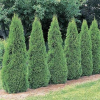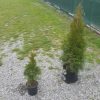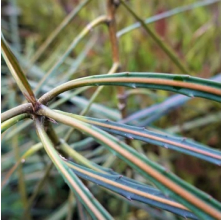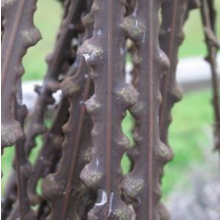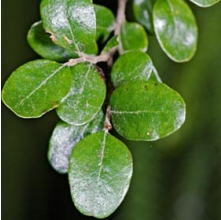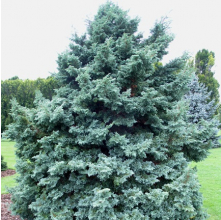Thuja occidentalis Smaragd
(Emerald Cedar)
Thuja occidentalis Smaragd
(Emerald Cedar)
Prices:
| Each | 20 or more | |
|---|---|---|
| 10L Pot | $40.00 | $35.00 |
| 2.5L Pot | $9.50 | $9.00 |
Details:
| Type: | Tree |
| Growth Rate: | Medium |
| Mature Height: | 3 m |
| Mature Width: | 1 m |
| Site Condition: | Coastal, Exposed, Frost Tolerant, Heavy Soil, Loamy Soil, Sandy Soil |
| Sun: | Full Sun, Part Shade |
| Drainage: | Dry, Moist |
| Frosts: | Hardy |
| Features: | Suitable for hedging or shelter. Foliage colour: Green. |
Thuja occidentalis Smaragd, commonly known as Emerald Green Arborvitae, is a cultivar of Thuja occidentalis, a coniferous evergreen tree from the family Cupressaceae. Smaragd is a popular and widely cultivated cultivar known for its distinct appearance and landscaping uses.
Smaragd is a compact, slow-growing evergreen tree that has a narrow, columnar shape with dense branching, forming a symmetrical, pyramid-like silhouette. The foliage is arranged in flattened sprays that are scale-like and tightly packed, giving the tree a fine-textured, feathery appearance.
The foliage of Smaragd is its most distinctive feature. The scale-like leaves are emerald green in color, hence the cultivar name "Smaragd," which means "emerald" in German. The foliage retains its color throughout the year, providing year-round interest in the landscape. When crushed, the leaves release a pleasant aroma.
Smaragd produces small, inconspicuous cones that are about 0.5 inches (1.3 cm) long and initially green, but turn brown as they mature. The cones are typically hidden deep within the foliage and are not a prominent feature of the tree.
Smaragd has a slow to moderate growth rate, making it relatively low-maintenance compared to other evergreen trees. It prefers full sun to partial shade and well-drained, moist soil. Once established, it is drought-tolerant and can withstand a wide range of soil conditions. Smaragd is generally resistant to pests and diseases, although it may be susceptible to some fungal diseases in humid conditions.
Due to its compact size, narrow form, and attractive emerald green foliage, Smaragd is a popular choice for hedges, screens, and foundation plantings. It can also be used as a focal point in small gardens, rock gardens, or as a specimen tree in larger landscapes. Smaragd is commonly used in urban and suburban landscapes for its year-round green color and low-maintenance requirements.
Overall, Thuja occidentalis Smaragd is a versatile, slow-growing evergreen tree with a distinctive emerald green foliage, making it a popular choice for landscaping projects where a compact, columnar form and year-round green color are desired. Evergreen. Hardy.
Notice: Taking orders now for summer delivery

